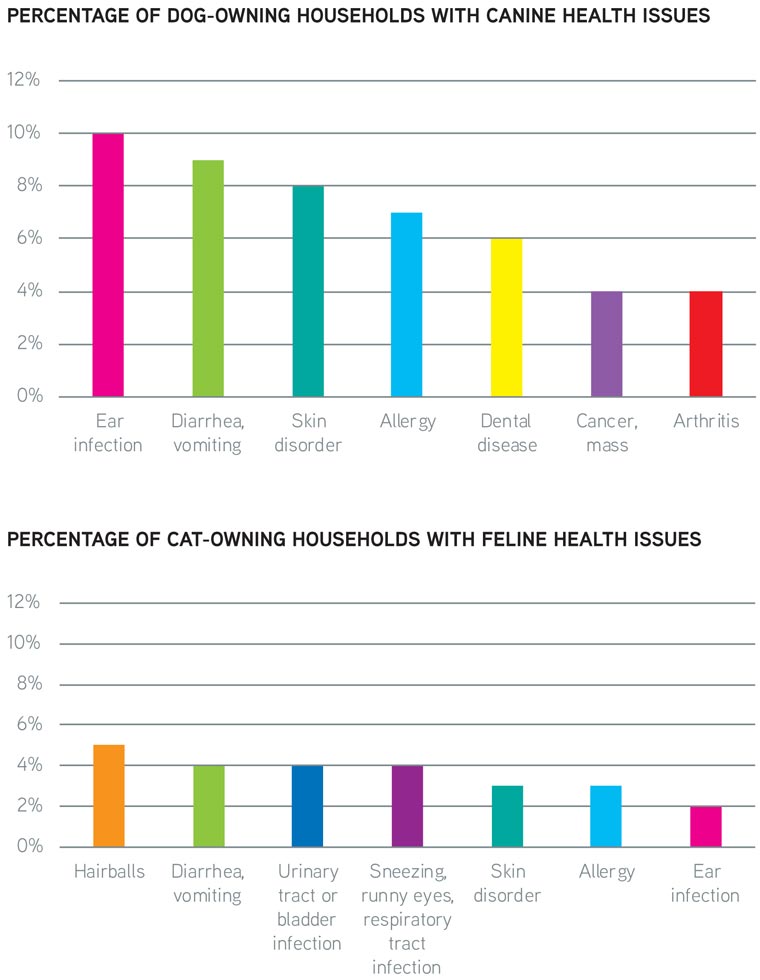
February 15, 2020
More itchy pets? No problem
 It’s hard to tell if there are more itchy dogs and cats than ever or if it just seems that way because more pet owners have realized that itchiness in pets is not the norm—and is treatable.
It’s hard to tell if there are more itchy dogs and cats than ever or if it just seems that way because more pet owners have realized that itchiness in pets is not the norm—and is treatable.
Conditions that can cause itchiness were among the top seven health issues for dogs and cats as of 2017, according to the 2017-18 edition of the AVMA Pet Ownership and Demographics Sourcebook. For dogs, ear infections were the top health issue, and skin disorders and allergies were third and fourth. For cats, the top seven health issues included skin disorders, allergies, and ear infections.
According to the 2018 Banfield State of Pet Health Report, flea allergy increased 12.5% in dogs and 67.3% in cats from 2008-17. In the same time frame, environmental allergies increased 30.7% in dogs and 11.5% in cats.
Fortunately, veterinary dermatologists say there are more treatments available than ever for itchy pets.
What’s complicated with dogs with allergies is it’s very similar to humans with atopic eczema, and they call it the atopic march. And essentially what that means is, every year is going to typically get more challenging for that patient, as the allergies get worse.
Dr. Jackie Campbell, veterinary dermatologist, Animal Allergy & Dermatology of Colorado
The most popular session at AVMA Convention 2019 was Dr. Lori Thompson’s talk “Itchy Felines: Is it Really a Fluoxetine Deficiency?” The title was meant to emphasize that itchiness in cats obviously has multiple causes. Also at the convention, Dr. Jackie Campbell presented two sessions on itchy pets: “Diagnostic Approach to the Pruritic Dog” and “Dermatology Toolbox: The Pruritic Pet.”
Itchy dogs
The Itchy Dog Project from 2017-19 at the University of Nottingham in England investigated potential causes of atopic dermatitis and skin allergies in dogs.
In Labrador Retrievers and Golden Retrievers, environmental risk factors for atopic dermatitis included being raised in an urban environment, being male, being neutered, receiving flea control, and being allowed on upholstered furniture. Protective factors included living with other dogs and walking in the woods, fields, or beaches.
Itch severity in dogs with atopic dermatitis was associated with increased frequency of behaviors often considered problematic, such as mounting, chewing, hyperactivity, eating feces, begging for and stealing food, attention seeking, excitability, excessive grooming, and reduced trainability.
Dr. Campbell, a veterinary dermatologist with Animal Allergy & Dermatology of Colorado, said itchiness in dogs can be very frustrating for their owners, and she believes the problem of pruritus is increasing.
Allergy is the most common cause of pruritus in dogs and can be particularly daunting because it is a lifelong condition. The tricky part is handling any secondary infections. If a dog develops an infection with every bad allergy flare and receives antimicrobials, the patient is set up for resistant bacteria. It is not uncommon in Dr. Campbell’s practice to have cases in which the only remaining option is a daily injectable antibiotic requiring weekly monitoring to ensure the kidneys are tolerating treatment.

Dr. Campbell said two new treatments from Zoetis Inc. for atopic dermatitis, Apoquel and Cytopoint, changed the allergy management toolkit for most dogs—although cyclosporine and steroids are still options, despite possible adverse effects.
“What’s complicated with dogs with allergies is it’s very similar to humans with atopic eczema, and they call it the atopic march,” Dr. Campbell said. “And essentially what that means is, every year is going to typically get more challenging for that patient,” as the allergies get worse.
Allergy shots are Dr. Campbell’s favorite way to manage young dogs with environmental allergies because about 70-75% of dogs will improve, with a reduction in the severity of clinical signs of 50% or more. Immunotherapy starts to work within four to six months but may take up to a year. The clinic teaches owners how to do the injections themselves. Dr. Campbell noted that immunotherapy costs for a 150-pound Great Dane are similar to those for a 5-pound Chihuahua, which is not true for other treatments.
Food allergies also can be a cause of pruritus in dogs. The other primary causes for dogs are parasites—notably fleas—and skin infections. Skin infections themselves can have a variety of underlying causes such as insufficient antimicrobial treatment, immunosuppression secondary to corticosteroid administration, and allergies.

Work by Zoetis
At AVMA Convention 2019, Zoetis launched Itchy Pet Awareness Month to occur every August. The company has been campaigning in recent years to increase awareness among dog owners that itch in all its manifestations is not normal behavior. Instead, it is a reflection of a disease, said Dr. Andy Hillier, a veterinary dermatologist who is director of dermatology medical strategy for Zoetis Petcare.
According to data from Vetstreet Inc., a provider of marketing and communication services for veterinary practices, the number of dogs seen by veterinarians for itch increased almost 50% from 2013-18. Dr. Hillier thinks the data reflect an increase in the incidence of allergic disease, similar to the situation for humans, and an increase in dog owners bringing in dogs for treatment. He added that allergies are the underlying cause of most ear issues as well as the most common cause of skin infections in dogs.

Zoetis conducted a focused program of research and development 10 years ago on atopic dermatitis in dogs, Dr. Hillier said. The company was looking for treatments that would be effective and safe in the short and long term and that would meet owner needs. By studying the mechanisms of the disease, Zoetis learned how to target treatments toward specific irregularities in the immune system associated with allergic dermatitis.
Apoquel and Cytopoint target and neutralize the activity of allergy-related cytokines to provide relief for dogs with allergic and atopic dermatitis. Apoquel is a daily tablet, and Cytopoint is an injection given in the veterinary clinic that lasts four to six weeks.
Dr. Hillier said Apoquel has become the top-selling product in the U.S. animal health industry, according to data from the Executive Animal Health Study Center (CEESA) based in Belgium. He said Apoquel has surpassed the flea and tick preventives at different points during the last couple of years, the first time that a therapeutic agent has surpassed the flea and tick preventives that had dominated forever.
Itchy cats
Pruritus is a problem for cats, too. A 2006 study in JAVMA, “Underlying medical conditions in cats with presumptive psychogenic alopecia,” found medical causes of pruritus in 16 of 21 cats with self-induced hair loss. Three cats had a combination of a medical cause of pruritus and psychogenic alopecia, and only two cats had psychogenic alopecia alone (J Am Vet Med Assoc 2006;228:1705-1709).
Dr. Thompson, a veterinary dermatologist with Animal Allergy & Dermatology Center of Indiana, doesn’t think the incidence of pruritus in cats is increasing. She thinks the ability of veterinarians to recognize the problem and the increased willingness of cat owners to seek treatment are at least partially responsible for the growing number of patients.
“The treatments we have to offer now are so much better than what we had 10 years ago,” she said. “It’s a better time to be a cat with skin disease than it was years ago.”
It’s a better time to be a cat with skin disease than it was years ago.
Dr. Lori Thompson, veterinary dermatologist, Animal Allergy & Dermatology Center of Indiana
To treat allergies in cats, Dr. Thompson said, veterinarians have immunotherapy, cyclosporine, and better diets for food trials. Apoquel can be used to treat cats, even though it is only labeled for use in dogs. Topical medications from the isoxalaner class can be used to treat ectoparasites in cats, and there are antifungal medications formulated specifically to treat dermatophytosis in cats now.
As for psychogenic alopecia, Dr. Thompson said it is a diagnosis of exclusion, which may respond to behavior-modifying drugs such as fluoxetine.
Dusty, the clinic cat at Animal Allergy & Dermatology Center of Indiana, is the toughest allergic cat case that Dr. Thompson has ever managed. Dusty was a client’s cat for three years before becoming the clinic cat. Her owner tried everything that the clinic asked, but in the end, it was too much for the owner to manage, so the owner allowed the clinic to adopt her.
At the time of adoption, Dusty turned out to be infected with methicillin-resistant Staphylococcus schleiferi and methicillin-resistant Staphylococcus pseudintermedius. She has both dietary allergies and environmental allergies. She eats a prescription diet, gets allergy shots twice weekly, has daily topical therapy, and receives a small amount of a corticosteroid.
“She continues to be a challenge but is just the best girl ever,” Dr. Thompson said.